Disclosure: Meeple Mountain received a free copy of this product in exchange for an honest, unbiased review. This review is not intended to be an endorsement.
Beyond the Sun (2020, Rio Grande Games) is one of the 20 best games I have ever played.
Often referred to as “Tech Tree: The Game” in circles both near and far, Beyond the Sun’s main feature is a branching technology tree that players use to gain better and more powerful actions during the game. While it is one of the ugliest ducklings in the board game stratosphere, I don’t care—the gameplay is so good that the game’s interesting decisions make up for an almost complete lack of aesthetic beauty.
At the Festival International des Jeux earlier this year, I had the chance to meet with the marketing lead at Cranio Creations, the Italian publisher who has given us some of the best medium-weight Euro designs of recent years, such as Golem and, most famously, Barrage, the Tommaso Battista and Simone Luciani design that has spawned so much love and so much additional content that Barrage has become a cottage industry in its own right.
During the meeting, I learned about a few of Cranio’s upcoming projects. The one that stuck out was a reskin of Beyond the Sun—a reimagined version of the base game called Beyond the Horizon. It was designed not only by Beyond the Sun’s original designer, Dennis K. Chan, but also Adam Hill, Matt Riddle and Ben Pinchback, the trio of designers behind a mix of lighter family-weight fare (River Valley Glassworks) and strategic roll-and-write games like Three Sisters and Fleet: The Dice Game.
I was intrigued just by the idea that this project was happening, let alone that this was going to be in my hands just a few months later. Beyond the Sun doesn’t have any rough edges (save for the look of it), and its recent expansion seemed to address the main game’s only real hole: more stuff, in the form of player powers, additional technologies and a solo mode. What could Beyond the Horizon add to the canon that the base game didn’t already have?
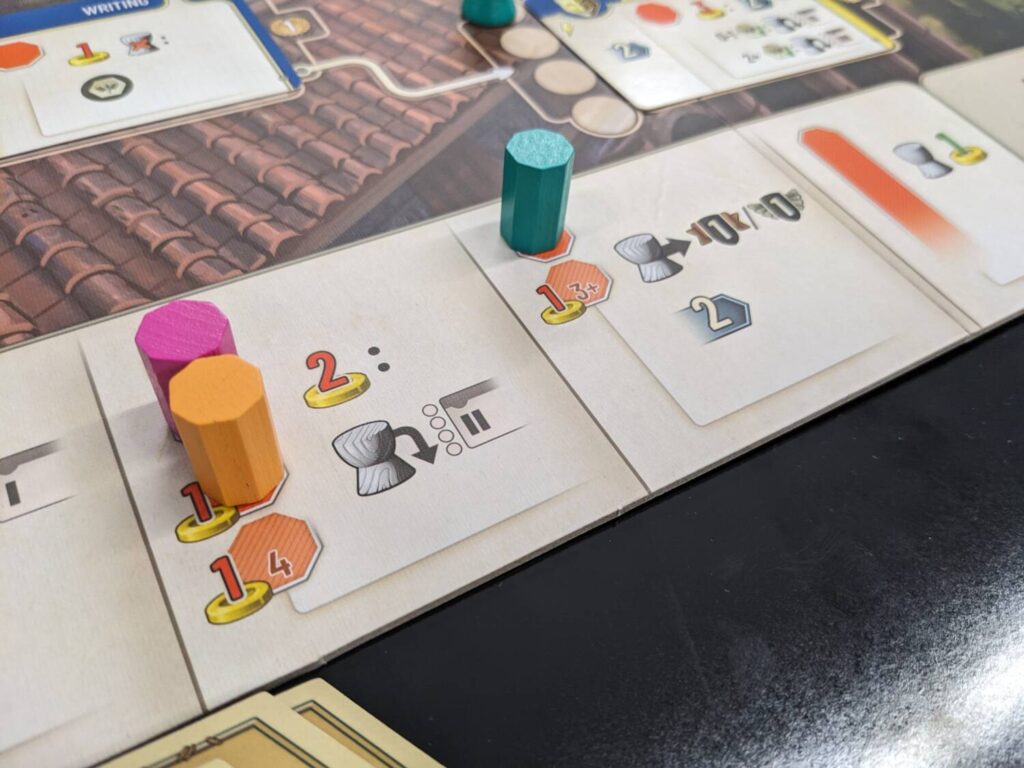
One other thing intrigued me: Luciani did the development work on the new game. The guy that I think belongs on the tabletop version of Mount Rushmore (he had a hand in so many of my favorite games of the last 10 years) was polishing this new version of Beyond the Sun? The same guy who helped design Grand Austria Hotel, Tiletum, Lorenzo il Magnifico, and Nucleum? That told me I had to play the new game.
Cranio was kind enough to send an advance copy of the game, which will be going up for pre-order as this review posts to our site. Now that I’m a few plays into my experience with Beyond the Horizon (once each at two, three and four player counts), one thing is clear—this new version attempts to shake up what some players feel is the toughest thing about Beyond the Sun: the Exploration board.
I personally love the original game’s Exploration board and the way it forces players to settle planets based on an area control mechanic that dictates which player currently has the right to take the Colonization action on a particular planet card. There are also a very limited number of planets that can be settled at any given time (three in a two-player game, or four in a 3-4 player game), so the chance to score points and drive towards end-game goals in Beyond the Sun make the Exploration portion of the game pretty tight, and sometimes very petty. (Watching players try to one-up the current control owner of a planet over multiple turns can be quite tedious, even if I love watching it.)
Beyond the Horizon upends the Exploration formula by asking players to slowly build a map of territory tiles that can be settled—and, later, fortified—by any player who has enough unit strength to take the action, even if an opponent has equal or greater unit strength on the same tile.
This is why you will either love the changes, or stick with the base game.

Here’s What Hasn’t Changed
Beyond the Horizon is, like Beyond the Sun, a 2-4 player single pawn action selection system that probably could use a solo mode. (This is a surprise mainly because Beyond the Sun’s expansion included this variant.) The game end is triggered when a certain number of goals are achieved based on player count, just like Beyond the Sun.
Here’s what basically hasn’t changed at all: the technology tree. Players still use their population to research technologies—techs are again ranked by level, between Roman numerals I-IV—and actions are taken by moving their pawn to a new action space every turn. Researching new technologies requires a connection to the next box in the chain (pre-requisites), and the first player to take the research action in an undiscovered section of the tree gets a small one-time bonus plus the right to pick the next technology.
One minor change to the tech tree is a welcome one—to begin the game, the level IV technologies are revealed on the tech tree. That way, you can plot the path you want to take based on that game’s public goals. Plus, the first player to research a level IV tech gets a juicy one-time bonus in addition to a second one-time bonus shown on the tech card as well as the points earned from the level IV tech. This ranges much higher than the base game and includes four points thanks to the space where the card is. (In Beyond the Sun, there was no four-point addition tacked on.)
So, 50% of the game is basically unchanged, with minor changes that are strictly better than the base game. So far, so good.
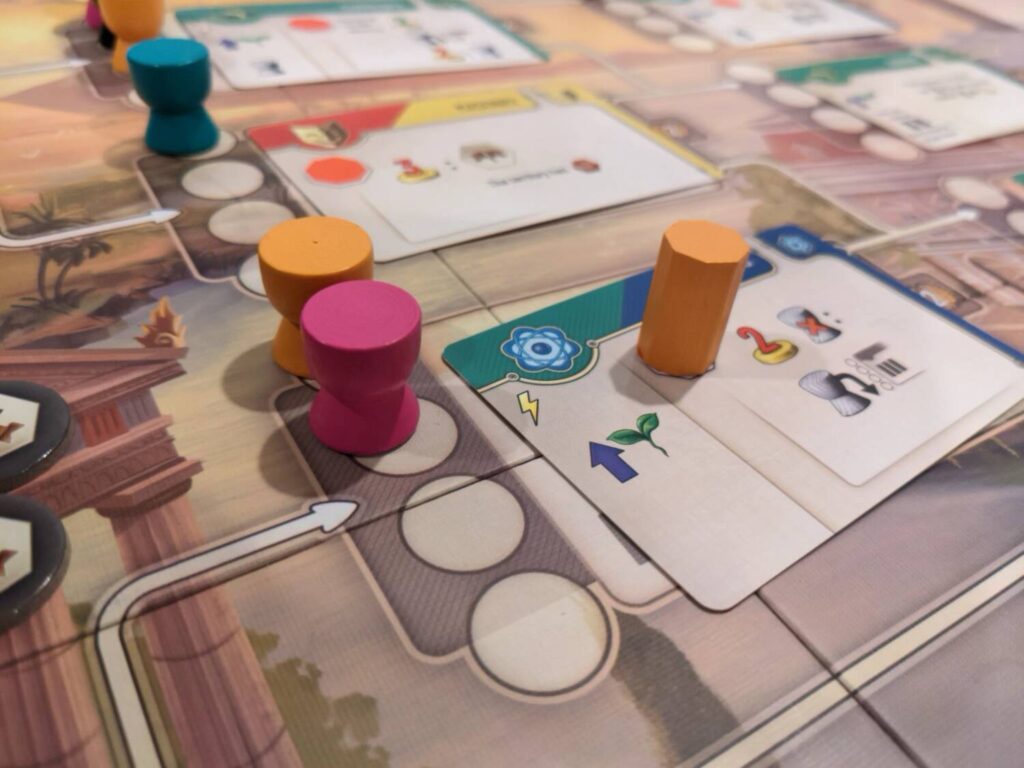
Player boards are slightly more complex now, but the changes lead to more exciting moments. (This is where it felt like the work that Hill, Riddle and Pinchback seemed most influential, with a river of combo opportunities in line with some of the work they’ve done previously on more complex roll-and-write games.)
The Automation track from Beyond the Sun is now the Investment track. As players move cubes from their production tracks, those cubes move to the top of their player board and trigger a few one-time bonuses that turned out to be surprisingly meaningful during my plays and offer more chances at sexy combos.
The board’s new complexity is twofold. First, each player has a personal set of four powers: two that are ongoing powers (one of which is available for the entire game), and two other powers. One of those is simply a one-time, immediate bonus. The other is an end-game scoring goal, triggered if a player removes all cubes from the new Infrastructure track, a third track to go along with the population and economy tracks from the original game. (Beyond the Horizon substitutes out ore from Beyond the Sun and swaps in cash…coins just make more sense based on the new game’s civilization game theme.)
The Infrastructure track represents this second level of complexity. It serves as the main focus of unlocks for the personal player powers, as well as a tile system that players will use during the Exploration portions of Beyond the Horizon. These new tiles, known as Construction tiles, essentially offer players a chance to overbuild territory tiles that have not been utilized to settle or fortify existing land.
So, the remaining 50% of Beyond the Horizon has been turned into a 4X-style game’s exploration elements, with complexity to match.
Players are going to have to make a choice. If you liked Beyond the Sun and thought it was just the right amount of difficulty, with a decent amount of interaction on the Exploration board, I would steer clear of Beyond the Horizon…the new game is a little bit heavier in terms of rules, and significantly less interactive on the Exploration map.
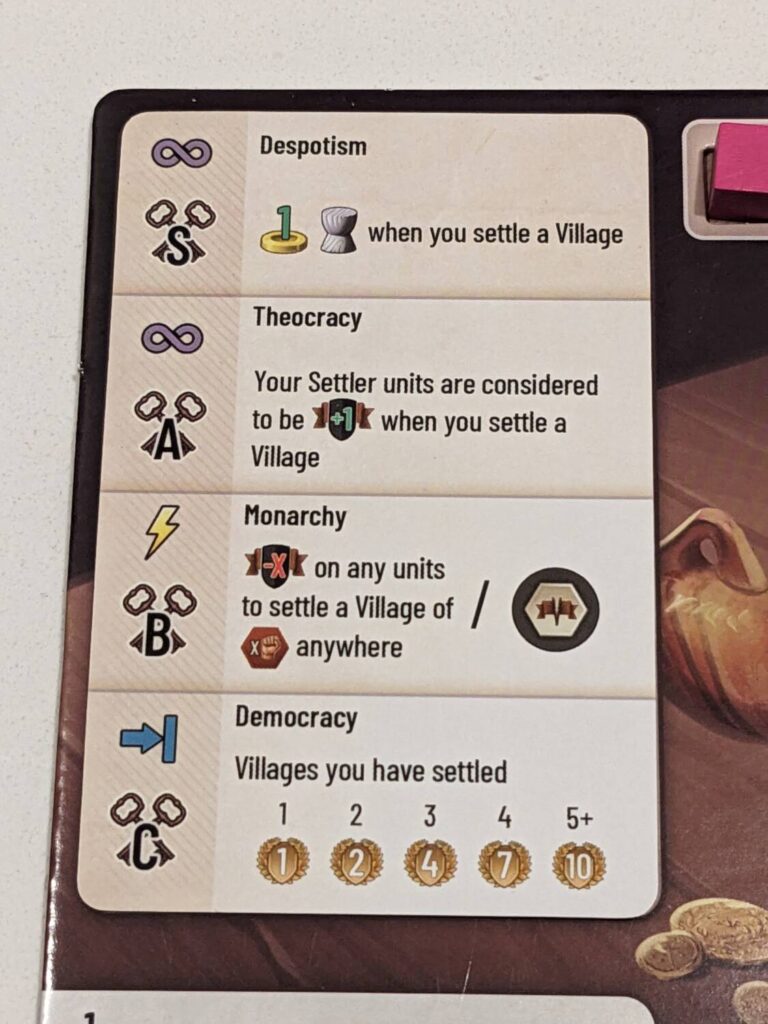
Wait, I Can PLAN My Settlement Actions?
Let’s talk about the new game’s version of Exploration.
In Beyond the Horizon, players will start on a map that includes a central hex tile known as the Cradle of Civilization and a starting territory tile for each player connected to the Cradle. These tiles serve as the entry point for new Population tokens that are assigned to the Exploration area.
The six-sided “cubes” (dice) from Beyond the Sun are gone. Those cubes featured either a population icon, a picture of a storage box (the inactive status, when a cube was still on the player mat), or a spaceship in one of four strength categories (1-4). In Beyond the Horizon these have been replaced by “Population Pawns”, wooden tokens that look like a thick bottle when placed in their inactive positions on the player board, or goblets when flipped over and made active.
This change is easily the worst thing about Beyond the Horizon, and everyone who joined me at the table for my plays had commentary to share, most of which was negative. The cubes from Beyond the Sun are perfect, fit squarely in each space on a player’s mat, and clearly indicate what they are to everyone at the table from every angle.
In Beyond the Horizon, these Population Pawns have to play triple duty:
- When they are moved from a player’s active area to a research slot, the pawn represents a Scholar.
- When the pawn is moved to the Exploration area and has a brown token showing their strength on top of the pawn, they are a Settler. Settlers can settle villages on territory tiles, build Construction tiles, and move into unexplored areas of the map.
- When the pawn is moved to the Exploration area and has a silver token showing their strength on top, they are a Soldier. Soldiers can fortify a city that was previously settled, but cannot explore new territory tiles nor can they build a Construction tile.
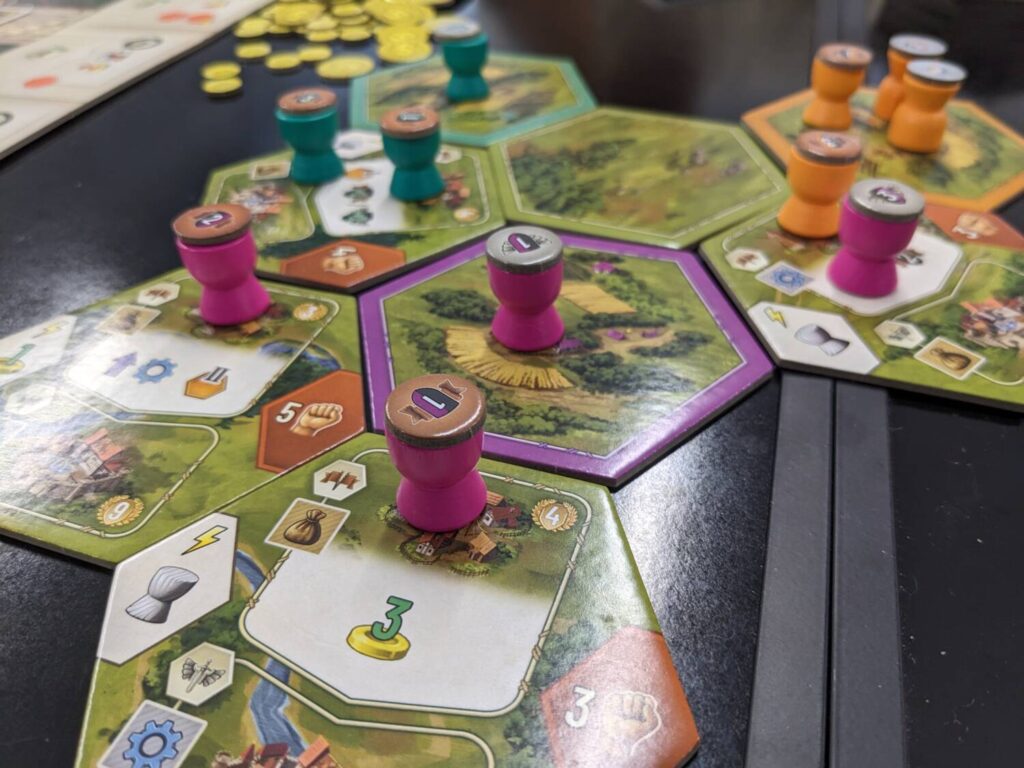
Here’s why the pawns don’t work—the Settler and Soldier tokens are comically fiddly. In one of my games, the small cardboard tokens fell off the pawns more than 50 times (I stopped keeping track at that point). On nearly every turn involving actions in the Exploration area of that game, someone was knocking over a token. It was a mess, and this was during a three-player game… it happened just as much in a two-player game with my wife. (For my final review play, I tried Beyond the Horizon with four players. I knocked a token off a pawn six times during the teach. I have pretty good hands, so I can only imagine what this experience will be like for people who struggle with personal dexterity.)
Now as bad as this system is from a token/physical standpoint, the way the system works as a game mechanic is fantastic. Players no longer have to have the majority on a tile in order to settle the territory to score end-game points. Because each territory has space to both settle it and later fortify it, multiple players can get in on the action and score points. The player who adds a territory tile to the map gets a tiny one-time bonus, and the player who settles the village gets a better bonus. Whether a player settles or fortifies a tile, they get a bump on one of the three tracks on their player mat.
The tiles themselves are a little busy, but we found with multiple plays that this issue worked itself out. And if a new tile has a strength rating that is too high for a player, they can take an action to overbuild an area with a Construction tile (as long as the original territory has no cubes or opposing player pawns on it) that allows for an immediate one-time bonus or end-game points, along with the chance to get another cube off a track.
The Exploration portion of Beyond the Horizon is almost completely different from the base game, but I still enjoyed it. The main downside? In most of my plays, players don’t fight over a single tile; they simply choose to expand in the opposite direction of other players. Early on, that’s hard to do thanks to the placement rules regarding new territory tiles. But by midgame, it felt like everyone was off settling new tiles as far away from competition as possible and trying to race other players to end-game public goals.
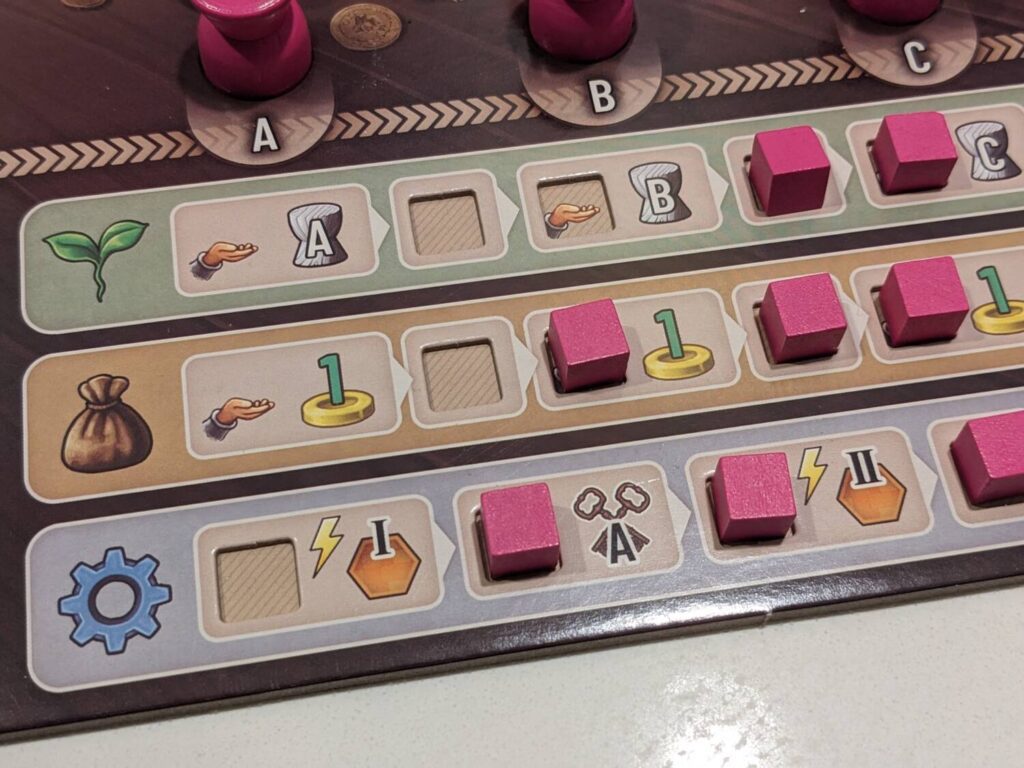
My favorite part about Beyond the Horizon is the newly added Expansion phase. After players move their action pawn to take an action, but before they produce more pawns or cash, a player can elect to take an optional expansion action. This could be to place a Construction tile, by reducing the strength of a Settler by just one point and paying a few coins. These Construction tiles are granted through bumps on the Infrastructure track or through one-time bonuses that are granted by some of the technologies.
The other expansion actions are to spend either a settle or fortify token, picked up through certain spaces on the technology board or through some of the bonuses on the player board or on territory tiles. These tokens allow a player to take the settle (previously Colonization) action during their main turn or to do it with a token after their main action instead.
Even juicier–when you are able to settle as your main action, then settle a different tile with a settle token on the same turn. (I only saw this once in my three games, but still, it’s dope!)
I LOVE the idea of settling and fortifying tiles as a bonus action. It also ensures that you no longer spend your turn setting up a Colonization action then having another player snake your hard work on their turn, which happened from time to time in Beyond the Sun. The combos in Beyond the Horizon are really juicy.
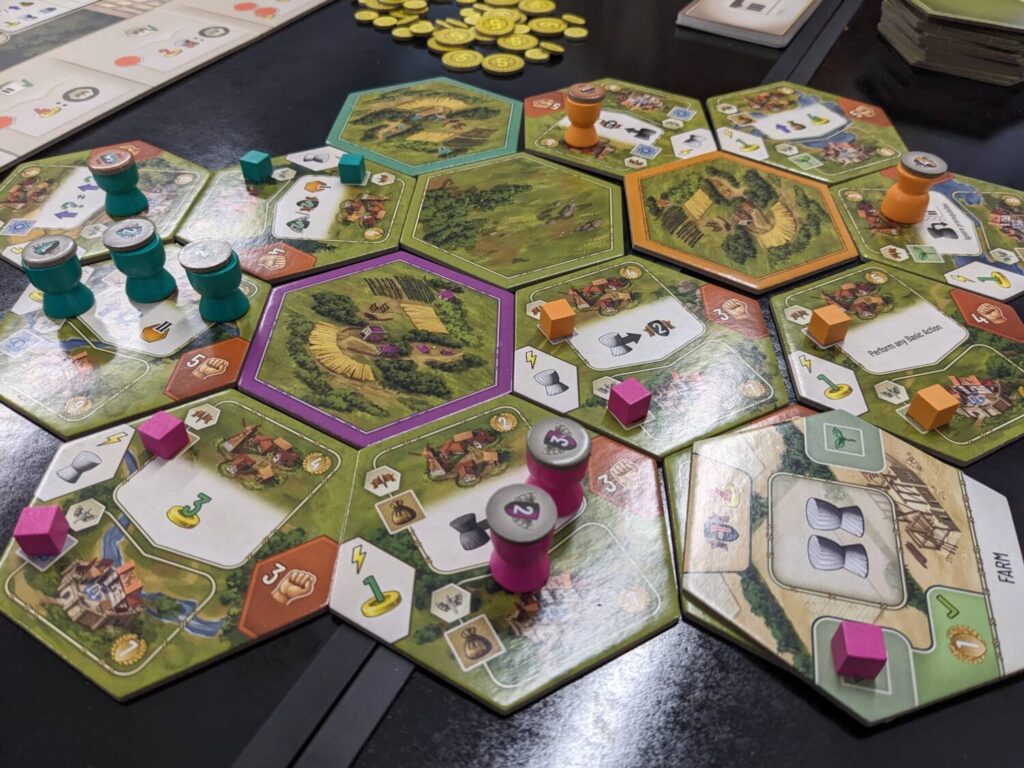
So, Where Ya At?
Beyond the Horizon is really good. As a massive fan of Beyond the Sun, I’m surprised at how much I enjoyed playing this new version despite such massive changes to a portion of the base game that I adore. I usually prefer my games to have more interaction, but the race to score points and execute combos in Beyond the Horizon got me excited every time I played, even in defeat. The way players string together actions and set up late-game triggers is a joy to watch.
Point totals are generally higher in Beyond the Horizon than they were in Beyond the Sun…in two of my three games, the winning player scored more than 80 points, with one game’s winner reaching 92 points. I never saw scores go that high in Beyond the Sun, in part because some of the new game’s scoring thresholds (level IV technologies, end-game scoring for fortifying cities, end-game personal goal scoring, etc.) are larger.
I’m thankful that my favorite part of both games, the technology tree, remained consistent. It is incredible to watch the tech tree grow, and watching skilled players line up new technologies that really focus a person’s opportunity to do certain actions better than anyone else. It still feels great to build up an engine of interesting actions that develop differently in each game. Plus, the goals in Beyond the Horizon do not automatically include researching a level IV technology or colonizing four systems, like Beyond the Sun did. That means that the three public goals (which are also worth more points in this version, maybe to make up for less available goals overall) are a little different and require a different approach every game. In one of my Beyond the Horizon plays, no one even researched a level IV tech, which was uncommon in Beyond the Sun.
Beyond the population pawns, a few other areas of Beyond the Horizon concerned me. One of them is around the tech tree cards and the player powers—I am very surprised that Beyond the Horizon didn’t come with more cards. I was sure there would be double the number of technologies on display. Also, there are only nine public goal cards, with only three included in each play.
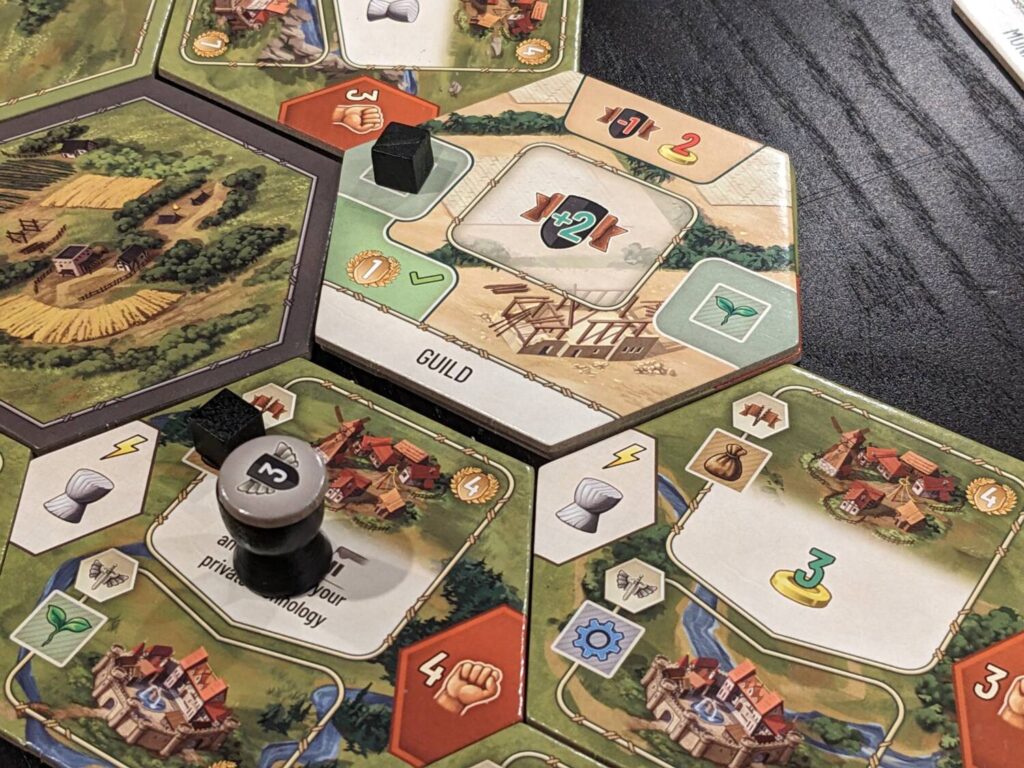
Look, I get it—more techs would require more time to playtest and develop to ensure none of the new stuff is too over- or underpowered. Still, I felt that more cards should be here. As it is, there’s plenty of room for tech tree expansion content for Beyond the Horizon.
The four “Government Cards” (player powers) offer a player unique ways to attack the game. However, across my three plays, one of the powers shined brightest: the card that allows a player to break the technology prerequisite rules and research techs with one less prerequisite. This one feels a bit broken; using this to cheat ahead on the tech tree is a massive game-changer. (For comparison, one card lets a player get a coin each time they go up on a track. The money is great…but it’s not opening up more innovative actions faster than other players can research them.)
On the upside, the powers are meant to be drafted before play begins. So, these aren’t completely random in their distribution. But they should be bid upon instead, by boosting every player’s starting money so that they can spend it on the government card they want most.
Beyond the Sun is a table hog, and Beyond the Horizon somehow requires more table space, mainly because the territory tile sprawl takes up more space by the end of the game. Gosh, my four-player game—featuring exploration areas for each player that sprawled outward in the direction of that player’s starting hex—used about 15 of the 20 included territory tiles and ate up my entire table. You need space for the Construction tile market, which usually has nine large hex tiles (and three hex tile draw decks) sitting within view of all players. The player boards are not any larger in the new game, but you’ll need a little space for the Settler/Soldier tokens and the Construction tiles in each player’s possession.
It’s…a lot.
Like the base game, you’ll want to ensure as many as four players have the space to sit facing up at the tech tree. While the new game relies less on card text and more on iconography, I found that it was disadvantageous to sit above the main board looking down at the flipped text on the cards. It was also really hard to figure out where to leave the exploration area so that all players could reach that as well as being able to move their pawn on the tech tree.
This might mean that Beyond the Horizon, like Beyond the Sun, is best played as a two- or three-player game.
Overall, Beyond the Horizon is a great time at the table. I will still play either game at the drop of a hat because I love the tech tree. I don’t think a player would need to own both games, but if you love the space theme and more area control interaction on the Exploration board, stick with Beyond the Sun. (I prefer the fight-y nature of the original game’s Exploration board, so Beyond the Sun is still my preference.)
If you want the tech tree experience in a heavier, more strategy gamer-friendly package, with little to no direct interaction in the exploration portion of the game, Beyond the Horizon is the pick. No matter what, you owe it to yourself to try one of the games in this system because each play is such a joy to discover new possibilities in the tech tree!


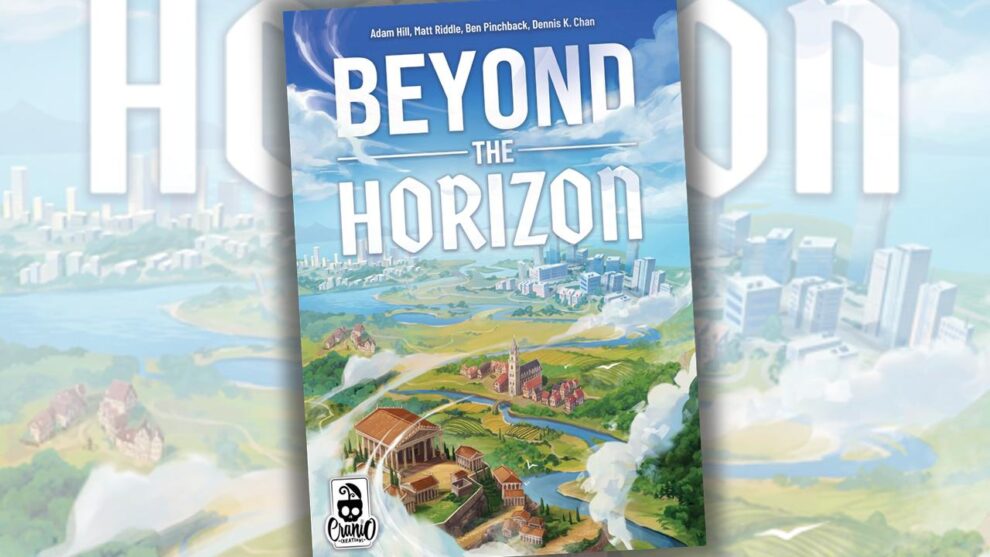
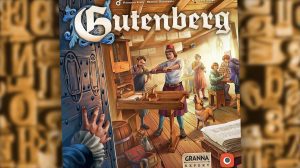

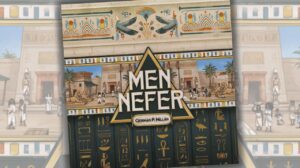





Add Comment